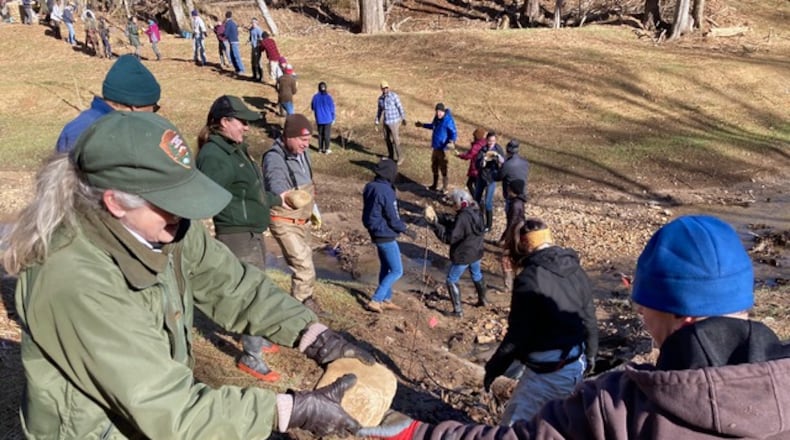In the fall of 2019, the Upper Chattahoochee Chapter of Trout Unlimited was searching for a project. At the time, they identified a then-unnamed tributary feeding into the Chattahoochee River that crosses National Park Service land inside Sugar Hill city limits. The urban stream was regularly dumping silt into the river where it was endangering spawning wild brown trout.
Crayfish Creek is heavily impacted by stormwater runoff from nearby development, degrading water management infrastructure and pressure from water regularly released through Buford Dam.
“The stream banks were badly eroded from the surges of water coming from the Chattahoochee River during dam releases and had become almost vertical,” stated Mark Romzick, president Upper Chattahoochee Chapter of Trout Unlimited. “That erosion was causing silt to be dumped into the river, endangering brown trout spawning grounds just below the mouth of the creek.”
Romzick went on to explain the silt flowing into the Chattahoochee was like “throwing a blanket” over the fish weir, a rock formation built originally by Native Americans, located just downstream where the creek enters the Chattahoochee. The rising silt levels were lowering the chances for trout eggs to survive.
Taking on the project to restore the banks of Crayfish Creek quickly became a much bigger project than Trout Unlimited anticipated. Grant funding, the help of additional Trout Unlimited chapters, numerous agencies, the city of Sugar Hill and over 300 documented volunteers have begun transforming the stream.
“I love this project,” said Sugar Hill Mayor Brandon Hembree. “Our community doesn’t always know about the natural resources we have right here. I’m really impressed with everyone coming together.”
Although this first phase only focuses on 500 linear feet of the total creek length, it’s already making a visible difference in the creek’s health.
Work began with trash clean up and removal of invasive plants like Chinese Privet and Japanese Stiltgrass. Next, the bank was graded to create a floodplain to reduce the speed of water moving through the area and coconut-fiber coir matting donated by Gwinnett’s Stormwater Management department, was installed.
In February, aquatic biologists and technical experts from Georgia’s Department of Natural Resources directed over 35 volunteers to extend the stabilization effort down into the creek itself. More than two pallets of stone, a pallet of boulders, and several huge logs were placed to form natural-looking structures that will serve as stabilizers and habitat for aquatic wildlife.
Columbia Engineering, which provided design plans required for permitting, partnered with the National Park Service to create a list of native shrubs, trees, grasses and sedges slated for planting. This native and biodiverse selection will eventually provide a strong root system that will help reduce erosion.
“Restoration of native vegetation and their root systems is critical to stabilizing the stream bank,” said Sarah Baker, fisheries biologist with the Department of Natural Resources Wildlife Resources Division.
With guidance from UGA’s Warnell School of Forestry and Natural Resources, volunteers met again March 5 to plant around 1,000 native plants surrounding the creek.
“People generally want to help the environment, they just don’t know where to begin,” Tixie Fowler, an environmental educator with Gwinnett County Soil and Water Conservation District explained. “By carefully documenting our process and organizing it into a template, we plan to share our strategies in a way that inspires others to focus on the tributaries that run through their own communities.”
About the Author
Keep Reading
The Latest
Featured

